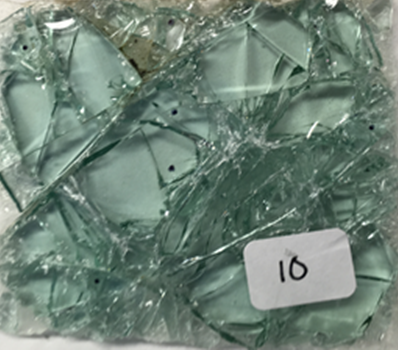Summary
The goal of this focus area is to improve the field of glass evidence analysis by developing new matrix-matched glass standards and by evaluating more objective approaches to evidence interpretation, such as the likelihood ratio. The latter will be accomplished through the development of glass databases that may be used to assign a significance to an association or exclusion in forensic casework. The projects focus on the two elemental analysis techniques X-Ray Fluorescence (XRF) and Laser Ablation Inductively Coupled Mass Spectrometry (LA-ICP-MS) that are commonly used by forensic glass analysts.
Description

Top view of broken laminated windshield glass.
Quantitative XRF Glass Database
Recent research efforts in the forensic trace field have focused on the development of databases to assign a significance to forensic evidence (i.e., to report the strength of an association or exclusion). In the forensic analysis of glass using µ-XRF, samples are typically compared using element intensity ratios. However, because of differences in instrumentation, the development of a database compiled with element ratios collected by different laboratories is not currently feasible. The collection of quantitative XRF data will address this limitation. Thus, this project focuses on the development of a quantitative XRF glass database that can be used by forensic practitioners to assign a significance to forensic glass evidence.
Glass Standards
The forensic community uses several glass standards and reference materials from NIST and abroad that are currently low in stock. Additionally, the community relies on published consensus values or on certified values that were collected more than 20 years ago and at sampling scales that are not relevant to the forensic community. This project aims to address these gaps by (1) reanalyzing elemental concentration (at trace and bulk sampling scales) for several commonly used glass SRMs with modern instrumentation and methods (i.e., LA-ICP-MS), and (2) collaborating with Dr. Almirall’s group at Florida International University to aid in the design and assessment of three new reference glasses.
Interpretation of Glass Evidence
Although the forensic community has reached a consensus on the analysis of glass evidence using LA-ICP-MS, there is currently no standardized method for the interpretation of glass evidence. Recent efforts in the community have focused on the use of databases to provide a significance to glass evidence using more objective approaches (e.g., likelihood ratio). This collaborative project, involves an inter-laboratory study, designed as a mock forensic case, that aims to evaluate the performance of the likelihood ratio for the interpretation of glass evidence.
Publications
"Evaluation of the Performance of Modern X-Ray Fluorescence Spectrometry Systems for the Forensic Analysis of Glass", Ruthmara Corzo, Troy Ernst, Joseph Insana, Claudia Martinez-Lopez, Jodi Webb, Emily Haase, Peter Weis, Tatiana Trejos, Forensic Chemistry, 31 (2022) 100447; https://doi.org/10.1016/j.forc.2022.100447.
"An interlaboratory study to evaluate the forensic analysis and interpretation of glass evidence", Katelyn Lambert, Shirly Montero, Anuradha Akmeemana, Ruthmara Corzo, Gwyneth Gordon, Emily Haase, Ping Jiang, Oriana Ovide, Katrin Prasch, Kahlee Redman, Thomas Scholz, Tatiana Trejos, Jodi Webb, Peter Weis, Wim Wiarda, Sharon Wilczek, Huifang Xie, Peter Zoon, Jose Almirall, Forensic Chemistry, 27 (2022) 100378; https://doi.org/10.1016/j.forc.2021.100378.
"An interlaboratory study evaluating the interpretation of forensic glass evidence using refractive index measurements and elemental composition", Ruthmara Corzo, Tricia Hoffman, Troy Ernst, Tatiana Trejos, Ted Berman, Sally Coulson, Peter Weis, Aleksandra Stryjnik, Hendrik Dorn, Edward “Chip” Pollock, Michael Scott Workman, Patrick Jones, Brendan Nytes, Thomas Scholz, Huifang Xie, Katherine Igowsky, Randall Nelson, Kris Gates, Jhanis Gonzalez, Lisa-Mareen Voss, Jose Almirall, Forensic Chemistry, 22 (2021) 100307; https://doi.org/10.1016/j.forc.2021.100307.

